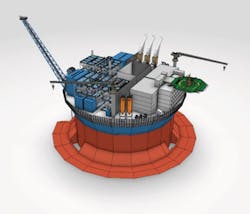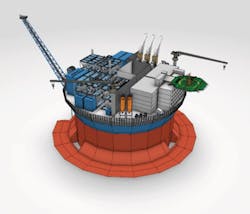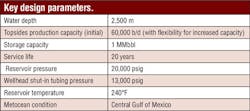Study examines new production system design for ultra-deepwater
Jelena Vidic-Perunovic
Doris-Inc.
Lihua Wang
Statoil
Donald Nordin
ABS Consulting
Frank Hopen
Sevan Marine
William Head
RPSEA
A new production platform concept is being examined for feasibility in the ultra-deepwater Gulf of Mexico, as a means of cost-effectively tapping into the region’s subsalt Paleogene reservoirs. Such fields are anticipated to be located far from existing infrastructure, and the proposed concept is designed to allow for early phased development.
Following concept screening, a round hull FPSO concept was selected as an alternative to existing ship-shaped solutions in the Gulf. The research project has been focusing on a Sevan-type cylindrical hull combined with a more cost-effective steel catenary riser configuration.
An intensive risk assessment was performed for the concept, and recommendations have been developed for the best means of managing risk. Regulatory assessment for the novel FPSO concept has been performed by the American Bureau of Shipping. The concept was then evaluated by comparing its technical properties and economical and regulatory aspects to other ultra-deepwater production concepts.
Study beginnings
Work on this effort began in earnest when the Research Partnership to Secure Energy for America (RPSEA) funded the study as part of its ultra-deepwater research program. The goal was to produce an alternative to the existing ship-shaped, hull-based solutions in ultra-deepwater GoM.
The study consisted of concept selection and model testing; only the concept selection results are presented here. The findings described a safe and cost-effective production system for subsalt Paleogene reservoirs, for hypothetical fields anticipated to be far from existing infrastructure and for early phased development. Following the concept selection, the production system has been assumed to be comparable to an FPSO concept for wet-tree application.
The new design is comprised of a spread-moored cylindrical hull of the Sevan type, combined with production steel catenary risers (SCRs), and directly offloaded by dynamically positioned (DP) shuttle tankers sized for delivery to a US Gulf terminal facility. Cylindrical hull concepts were evaluated by comparing characteristics to all other ultra-deepwater applicable floating production concepts. Other key metrics examined included hull global motions, riser configuration, weight of structure, need to disconnect from the hull, topsides arrangement, and ability to expand the production rate. Some of the key findings are described below.
Study parameters
The study examined a hypothetical field located in the ultra-deepwater GoM, far from existing infrastructure. The floater host would have a storage capacity of 1 MMbbl, located in 2,000 m to 3,000 m (~6,500 ft to ~9,800 ft) of water. Production would be gathered via four production risers from two separate drill centers. Each well would be equipped with wet trees controlled via an umbilical and power cable. The initial oil production is expected at 60,000 b/d. The flexibility for expanded production is included in project consideration. Processed oil would be directly offloaded via DP double-hull shuttle tankers sized for delivery to a US terminal facility. The study assumed that capacity for three additional risers for future water injection and/or future tie-ins would be required. A staged development is foreseen to minimize initial capex, but weight capacity upgrades and space were assumed to be available for future improved oil recovery initiatives and tie-in of additional wells.
Concept screening
With the growing spectrum of challenges related to ultra-deepwater development, it becomes even more important to select the best applicable solution(s) in the conceptual stage. The use of innovative concepts may become necessary in order to address geophysical, technical, regulatory challenges, while meeting low-cost requirements.
A technology assessment matrix was generated to reach the latest deepwater technology advancement. Various production systems are represented by their general hull classification or nomenclature, geographical and operation requirements, and the level of technological readiness (API scale 0-7). The concepts, represented by their exemplary units, covered the main existing subtypes.
Further, following the stated requirements for cost efficiency, safety, flexibility, and easy relocation, the choice of applicable concepts was narrowed down to round hull FPSOs and a semisubmersible with large storage. Of all the round hulls with storage, the Sevan-type cylindrical hull has the highest technology readiness level. Furthermore, due to inherently better motion characteristics of round hulls, the cylindrical hull is expected to accommodate steel catenary risers which are much more cost effective than free standing hybrid risers. For these reasons, the Sevan hull was selected to be concept engineered for application in the ultra-deepwater Gulf.
Concept engineering
The selected concept has been engineered to a higher level of detail, to correspond with project requirements. The concept design work involved efforts of multiple disciplines. However, here we limit the focus on hull structure and motions, mooring system and production riser analysis, topside arrangement, and offloading system. The robust preliminary concept design can be further optimized in later project phases.
Hull structure
The hull form is characterized by a cylindrical main body extended with a “bilge box” in combination with a horizontal damping plate at the lower section of the hull. The upper section of the hull flares out at an angle to the vertical up to the main deck elevation (tank top).
The process equipment, utility systems and accommodation blocks are located at an elevated fully plated process deck above the main deck. A bulwark is arranged between the main deck and the process deck, to protect against green water. The cylindrical part of the hull has been made faceted in order to optimize fabrication. The moonpool is located in the center of the hull and has a diameter of 30 m (98 ft). The lower section of the moonpool has an outward conical section. A hang-off frame is located in the center of the moonpool. The frame will be submerged during normal operation, but will be well above the waterline during installation of the risers. There will be fixed pipes running from hang-off frame to the inlet module on process deck. The tanks surrounding the moonpool mainly consist of cargo and ballast tanks.
Mooring system
The design of the mooring system satisfies the ABS safety criteria for the synthetic rope segment. A mooring system with 15 lines in three clusters was proposed. The anchors are placed about 2,600 m (8,530 ft) from the FPSO center, making the line go close to 45° through the water. The external mooring system would consist of:
- Anchor
- 158-mm R4S bottom chain segment including a subsea connection element
- 270-mm lower polyester rope segment
- Connection element
- 270-mm upper polyester rope segment
- 158-mm R4S top chain.
Maximum tensions are obtained when wind, waves and current acts directly toward a line cluster (in-line condition).
Riser analysis
In comparison to the ship-shaped FPSO combined with a free-standing hybrid riser (FSHR), the cylindrical FPSO has inherently more favorable motion characteristics and is therefore more SCR friendly. In addition, the hull was designed with a central moonpool for hanging off SCRs, and therefore coupling from roll/pitch motions should be minimized.
Based on preliminary motion data of the cylindrical FPSO, the feasibility of using SCRs has been numerically evaluated in terms of strength and fatigue performances. Riser strength and fatigue analysis was based on a non-linear time domain finite element program. At the current stage of the study, only first-order wave responses in irregular sea have been considered, whereas the response excited by low frequency motions and potential hull vortex induced motion (VIM), as well as vortex induced vibrations (VIV) were not taken to account at present.
Production riser wall thickness has been sized according to NTL No. 2009-G28 based on API RP 1111. The riser is hung off at the moonpool via a flex-joint, with a 10.5° hang-off angle. The hang-off location is approximately 5 m (16 ft) away from the hull center line. The nominal hang-off elevation is at the mean water line when the vessel is in a ballast condition. The riser was assumed to have insulation coating and be fully straked. The strength is according to API RP 2RD criteria. The minimum tension at the riser touch down point (TDP) occurs in a 100-year hurricane condition and the vessel at the near offset (10% of water depth).
Topsides analysis
The accommodation, utility blocks, the process modules and other equipment are located on a plated process deck lifted 6 m (19.6 ft) above the main deck. The main arrangement on the process deck is recognized by a division into two areas; a non-hazardous (safe side) and a hazardous side. The two areas are separated by a blast and fire wall. The moonpool ventilation shaft is arranged as an integrated part of this wall. The main deck layout includes utility blocks, mooring system winches and chain stoppers, marine system equipment and equipment related to gas processing plant.
The initial production rate of 60,000 b/d was satisfied, as well as the flexibility requirement for future expansion. Topsides arrangement (for initial and future expanded process) has met hull limitations for weight, available deck space and center of gravity. The combined topsides weight is based on a detailed topside equipment list and on similarity with the past FPSO projects, and includes the weights of all topside equipment, piping, electrical, instrumentation, bulk materials, safety facilities, buildings and the structural weights.
An overall contingency factor of 15% is applied to the total estimated topsides weights. It should be noted that the current suggested module layout is based on process module sizing and experience from Sevan’s previous projects of similar capacities. The elevation between levels, total height and thereby the total footprint of the process modules can be altered and optimized to suit a specific application and the required deck space of the FPSO.
In case of unchanged process parameters but increased oil production, the space on the deck and the weight capacity occupied by the additional equipment (production and mezzanine deck) will be used for expanded production trains. While the topsides were initially designed for 60,000 b/d, the new (future) production rate can be conservatively estimated to increase for at least one-fourth of the initial capacity; i.e., 75,000 b/d or more in total. The estimated additional production capacity is based on linear proportion between the area or weight taken by the basic and future topsides, and the existing (initial) production rate.
Risk assessment
A risk analysis was performed for this FPSO concept, and a HAZID workshop was facilitated by the ABS Consulting. The scope of the HAZID workshop was limited to the design and operations of the Sevan hull, risers, and topsides, as well as the offloading system. The objectives of this HAZID study were to identify current project assumptions; review the design of the floating production concept; identify the hazards associated with the design; evaluate the potential consequences and risks should these hazards be realized; establish the safeguards being proposed or employed to manage those hazards; identify specific areas where further detailed evaluation may be required; and recommend additional safeguards that should be considered, which will either reduce the likelihood of occurrence or mitigate potential consequences of the identified hazards.
Regulatory considerations
While not specifically a regulatory body in the true sense, classification societies among the other activities develop rules for the design and construction of vessels, and offshore facilities. For the existing Sevan-designed FPSO, the classification societies have offered a range of classification services. According to the regulatory review conducted by the ABS Consulting, the present Sevan cylindrical FPSO design would be approved by the leading classification societies.
Current US GoM regulations are specific to floating offshore installations (FOIs) and FPSOs with ship-shaped hulls. The main differences between the Sevan FPSO and the traditional FPSOs are: circular hull, no turret or swivel, permanently connected, and steel catenary risers.
Even though resembling the structural behavior of an FOI, according to recent response from USCG on the Design Concept Proposal from Sevan, the hull is planned to be classed as an FPSO, and it needs to follow the regulatory compliance matrix as provided in the Policy Letter No. 01-13. As the Sevan FPSO is a novel concept for US OCS, it may require additional review from the Bureau of Safety and Environmental Enforcement (BSEE) and USCG. The following section identifies parts of the system/design which may not fall under the regular certification regime.
Hull structure.Oil tanks aboard FPSOs are subject to 33 CFR Part 157 requirements and double-hull regulations from OPA 90, yet there are no clear requirements identified for the non-ship shaped hull structures by USCG or BSEE. As the new floating platform is a buoyant offshore facility that does not have a ship-shaped hull, as per the 30 CFR 250.910, the entire platform including risers and mooring system is subject to the platform verification program.
SCRs. There is no regulation for the type of riser that needs to be used in any particular facility type. Regulation 30 CFR 250.910 requires nomination of certified verification agent for risers.
Accommodation.The new Sevan FPSO will follow the SOLAS Chapter II, regulation 4, Section 5.1.2., specific to ship-shaped structures. The FPSO’s accommodation location and circular shape leads to the interpretation of the above regulation that the accommodation area needs to be adequately separated from cargo area, such that a single point of failure of a deck or bulk head shall not permit the entry of gas or fumes from cargo tanks into the accommodation area.
Non disconnectable. From the class point of view, there is no disconnectability requirement for an FOI facility in order to operate in GoM OCS. In recent communication, BSEE has stated they will consider a non-disconnect FPSO for use on the OCS through the BSEE’s formal review and approval process.
Cost advantages
The low cost of the cylindrical FPSO concept, as compared to other concepts, is based on following project outputs:
- Low lightship weight, including large storage capacity
- The hull does not weathervane; therefore a turret is not included in design but the hull is spread moored
- SCR utilization is based on favorable motion characteristics.
The low cost estimations are related to spread-moored solutions, whereas the application of a far more complex turret mooring would significantly increase the cost and impact schedule and equipment supply timeframe. For example, an internal turret designed for the harsh environment and large number of risers can cost on the order of $100 million.
Furthermore, the cylindrical Sevan hull has advantages related to construction timeframe. The construction of this axisymmetrical and modular hull is efficient, with high repeatability of standard blocks around the circle. However, for the novel application in the US Gulf of Mexico, the total development time for the cylindrical hull FPSO may be extended due to regulatory compliance and additional reviews from US federal authorities.
The riser analysis implies the possibility for the application of an SCR configuration. As compared to a ship-shaped FPSO, the FSHR configuration requires a much higher capex, where the capex for lazy wave steel riser is assumed to be about 30% higher than that for a SCR configuration.
Conclusions
The production system selected in this study is the FPSO system based on cylindrical hull of the Sevan type. The concept has been “first order” engineered to correspond to the technical, geophysical, regulatory, and economical requirements of the stakeholders, and to satisfy the limitations of construction, integration, manufacturability and offloading. The favorable motions of the hull and the top connection point allow for utilization of a more cost-efficient riser type, than the existing ship-shaped FPSO solutions in the Gulf. However, in future phases, a more comprehensive hydrodynamic analysis must be applied.
The present concept offers local storage in the hull, a cost-efficient riser configuration, modularity and symmetry of the hull which implies easy construction, and no need for turret mooring/riser system. This last point is based on the fact that the hull that does not weathervane, and has inherently better motions than a ship in hurricane and sever weather conditions.
Due to complexity and cost of ultra-deepwater projects, operators are looking toward phased development in order to reduce the risk, and to shorten the time to market. Therefore the design of the production facility is flexible, both with regard to expansion of production or reservoir dynamics and relocation. It has been proven in present study that initial and expanded production rate can satisfy the limitations from the hull.
A review of classification society rules by ABS Consulting indicates that the present Sevan cylindrical FPSO design for ultra-deep Gulf would not be prohibited by any of the major classification societies. However, since this concept is novel for the GoM, it is very likely that federal authorities would require additional reviews and approvals. Therefore, federal authorities have been involved and BSEE engaged early on in the project, in order to establish a robust design.
Acknowledgment
Based on a paper presented at Deep Offshore Technology International, held October 13-15, 2015, in The Woodlands, Texas.



